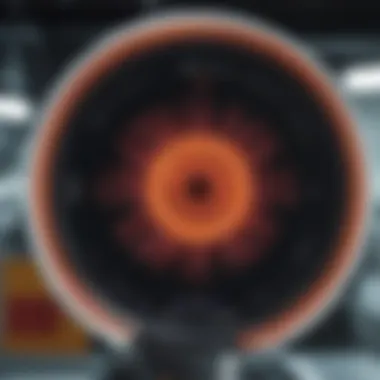Exploring the Helios Mass Cytometer in Biomedical Research


Intro
The Helios Mass Cytometer represents a significant advancement in the field of data analysis at the single-cell level. This device integrates state-of-the-art mass spectrometry with traditional flow cytometry, allowing researchers to measure an extensive array of parameters simultaneously. As the demand for precise and comprehensive analysis in biomedical research grows, tools like the Helios become increasingly relevant. This examination delves into the operational principles of the Helios Mass Cytometer, explores its broad spectrum of applications, and discusses both the benefits and limitations it presents in scientific research.
Methodology
Study Design
The examination of the Helios Mass Cytometer employs a qualitative study design. The focus is on understanding the operational mechanism of the device and its effectiveness in various research scenarios. This includes a review of literature, case studies, and direct input from researchers who utilize the Helios in their work. This multi-faceted approach helps to capture a comprehensive perspective on the functionality and significance of the mass cytometer.
Data Collection Techniques
Data is collected primarily through two methods. First, literature review involves analyzing peer-reviewed articles, technical papers, and operational manuals related to Helios. This provides foundational knowledge of its design and use cases. Second, interviews with researchers are conducted. These individuals possess hands-on experience with the Helios and can offer practical insights into its applications and challenges.
Applications
The Helios Mass Cytometer has diverse applications in various research areas. It is highly beneficial in immunology, oncology, and cellular biology. Specifically:
- Immunology: It assists in characterizing immune cell populations, leading to better understanding of immune responses.
- Oncology: The system is used for profiling cancer cells, providing crucial information for personalized medicine.
- Cellular Biology: It enables comprehensive analysis of cellular functions and interactions.
Discussion
Interpretation of Results
Results obtained from the Helios Mass Cytometer can yield detailed insights into cellular populations and their dynamics. By measuring multiple markers, it allows for complex data interpretation, which can indicate biological processes and disease mechanisms.
Limitations of the Study
Despite its sophistication, the Helios Mass Cytometer does have limitations. The high cost of equipment and operational complexity can restrict its use in smaller laboratories. Moreover, the interpretation of the data requires advanced skills, which may not be readily available in every research environment.
Future Research Directions
Future research should focus on enhancing the accessibility of this technology. Simplifying the operation and interpretation can widen its application across various research disciplines. Additionally, ongoing studies exploring improvements in sensitivity and accuracy will further solidify the Helios's role as a cornerstone in biomedical research.
The Helios Mass Cytometer epitomizes the future of single-cell analysis, pushing the boundaries of scientific understanding.
In summary, the Helios Mass Cytometer offers a profound capability for single-cell analysis through its integration of mass spectrometry and flow cytometry. By examining its methodology and implications in research, we gain a clearer understanding of its impact on science.
Prelude to the Helios Mass Cytometer
The Helios Mass Cytometer marks a significant advancement in the realm of biomedical research. By providing a platform that merges mass spectrometry with flow cytometry, it offers unique capabilities for analyzing cellular characteristics. This introduction serves to underscore its importance as a tool for researchers aiming to insightfully examine complex biological systems. Understanding the functionality and relevance of the Helios system is essential for any professional engaged in cell biology, immunology, and related fields.
Definition and Significance
The Helios Mass Cytometer is an instrument designed specifically for high-dimensional single-cell analysis. It utilizes mass cytometry technology, which permits the simultaneous measurement of multiple parameters at the level of individual cells. This capacity to evaluate numerous markers enhances the understanding of cellular heterogeneity and functional states. The significance of this technology lies not only in its innovative approach but also in its applications across various scientific domains, including but not limited to immunology and cancer research. The ability to analyze cells with such precision can lead to significant breakthroughs in understanding diseases and how to treat them effectively.
Historical Background
The journey of mass cytometry has its roots in traditional flow cytometry, which evolved significantly over the years. Mass cytometry emerged in the early 2000s, pioneered by the development of the first mass cytometer model by CyTOF, enabling the use of metal-tagged antibodies. The Helios Mass Cytometer further refines these capabilities by allowing for a greater number of parameters to be measured simultaneously. This transition from traditional methods reflects the ongoing demand for more detailed and complex analysis in biomedical research. Insights gained from the Helios can be traced back to foundational work done in the fields of cytometry and mass spectrometry, showcasing an evolution driven by technological advancements.


Comparison with Traditional Cytometers
Traditional flow cytometers have long been the standard for analyzing and sorting cells based on their physical and chemical characteristics. However, these devices generally allow for the measurement of a limited number of markers, usually around 10-15. In contrast, the Helios allows researchers to assess over 40 different parameters at the same time, significantly enhancing data richness.
Some key differences include:
- Parameter Measurement: Traditional cytometers are limited in the number of fluorescent markers. The Helios Mass Cytometer quantifies isotopes instead, enabling the analysis of hundreds of parameters.
- Data Resolution: The mass cytometer provides higher resolution in identifying cellular populations due to the precise measurement of mass differences between isotopes.
- Sample Handling: While traditional systems often require strict controls over fluorescent signal overlap, the Helios mitigates this complication, reducing the potential for data misinterpretation.
As research demands grow, the Helios Mass Cytometer stands out as a pivotal tool for modern scientists seeking deeper insights into the cellular underpinnings of health and disease.
Principles of Operation
Understanding the principles of operation of the Helios Mass Cytometer is crucial for gaining insights into how this instrument functions and its contributions to biomedical research. The integration of mass spectrometry with flow cytometry allows researchers to characterize cells at an unprecedented level of detail. This section will delve into the core concepts driving mass cytometry, the nuances of sample preparation, and how data is acquired effectively.
Mass Cytometry Fundamentals
Mass cytometry represents a significant advancement in high-dimensional cellular analysis. At its core, this method employs metal-tagged antibodies that bind specifically to cellular antigens. Once these tagged antibodies attach to their target proteins, cells pass through a laser that vaporizes them. This process produces ions, which are subsequently analyzed by mass spectrometry. The mass-to-charge ratios of these ions allow for the identification and quantification of various markers.
The Helios system can measure over forty parameters simultaneously at the single-cell level. This capability vastly improves upon traditional methods by allowing comprehensive cellular profiling without the limitations associated with fluorescence techniques. Mass cytometry provides quantitative data, which is less prone to overlap and compensation issues compared to traditional cytometers.
Sample Preparation Techniques
Effective sample preparation is vital in ensuring reliable mass cytometry results. The initial steps include careful cell staining with metal-conjugated antibodies. One pivotal consideration is the titration of these antibodies to achieve optimal binding saturation. Improper titration can lead to nonspecific binding or signal loss, severely impacting data quality.
Once stained, samples often undergo a process of fixation. Fixation helps to preserve cellular structures and antigen integrity. After fixation, cells need to be washed thoroughly to remove excess unbound antibodies. This step is crucial because unbound antibodies can introduce noise into the data, leading to misinterpretations.
Besides washing, another important procedure is resuspending the cells in a suitable buffer. The choice of buffer affects the stability of the metal tags and the overall performance of the mass cytometer. The goal is to ensure that the cells remain intact and viable for analysis while minimizing background noise.
Data Acquisition Process
The data acquisition process in mass cytometry is remarkable for its efficiency and detail. Once the sample is prepared, it is introduced into the Helios Mass Cytometer. The instrument employs an inert gas, usually argon, to facilitate the aerosolization of the cells. The growth of the aerosol is critical as it determines how well the cells are transported into the ion source.
After passing through the ion source, the resulting ionized particles are directed into a time-of-flight mass spectrometer. Here, they are separated based on mass-to-charge ratios. The time it takes for each ion to reach the detector corresponds to its mass, allowing for precise identification of the cellular markers.
The data generated during this phase is complex. To manage this complexity, advanced software tools are essential for processing and interpreting the information. Sophisticated algorithms help to convert raw data into meaningful results, enabling researchers to visualize cellular characteristics effectively.
Key Insight: The strength of the Helios system lies not only in its ability to measure numerous parameters simultaneously but also in how well it processes and interprets large datasets.
Applications in Biological Science
The Helios Mass Cytometer represents a significant advancement in biological science applications. Its unique capability to analyze multiple parameters at the single-cell level provides researchers with a fine-tuned instrument for exploring cellular heterogeneity. This precision is crucial for understanding complex biological systems, particularly in fields like immunology, oncology, and stem cell research. The insights garnered from Helios technology can enhance disease understanding, treatment strategies, and diagnostic methodologies.
Immunology Research
In immunology, the Helios Mass Cytometer plays a fundamental role in characterizing immune responses. The output from this system allows for detailed profiling of immune cell populations, revealing critical information about cell activation, differentiation, or dysfunction. For instance, researchers can use this technology to analyze T cells or B cells simultaneously, observing various markers that define their functional states.
The ability to measure dozens of parameters at once offers a level of granularity previously unattainable. This aids in identifying rare cell types or subsets in complex samples, advancing our grasp of autoimmune diseases, infections, or responses to vaccines. The interplay of cellular behaviour can be mapped out intricately, leading to better-targeted therapies and improved vaccine designs.
Cancer Research Contributions
In cancer research, the Helios Mass Cytometer has proven invaluable. It allows for in-depth analysis of tumor microenvironments, where cellular interactions play a vital role in cancer progression or response to treatment. Understanding these dynamics is crucial for developing personalized cancer therapies. By utilizing the Helios, researchers can identify distinct immune cell populations within tumors, assess their states, and analyze how they affect tumor growth or inhibition.


Furthermore, the capacity to track changes in these populations over time provides insights into how cancers evolve resistance to therapies. For example, examining the immune landscape before, during, and after therapy can identify which immune responses are effective and which are not. This data is essential for designing innovative treatment protocols that enhance patient outcomes.
Stem Cell Research Advancements
Stem cell research stands to benefit significantly from the capabilities of the Helios Mass Cytometer. Understanding stem cell differentiation and the factors that influence this process is key for applications in regenerative medicine. The Helios allows for the detailed examination of stem cell populations, fostering insights into their behavior and their potential for regeneration or tissue repair.
Moreover, by analyzing the molecular changes as stem cells differentiate, researchers can pinpoint markers that signal particular phases of maturation. This information can lead to advancements in therapies that harness stem cells for treating conditions like neurodegenerative diseases or injuries. In this context, the Helios Mass Cytometer does not merely measure; it reveals the intricate ballet of signals that govern stem cell dynamics.
In summation, the applications of the Helios Mass Cytometer span vital areas in biological science, driving advancements in immunology, cancer research, and stem cell studies, ultimately leading towards a more nuanced understanding of biology and better therapeutic approaches.
Data Analysis and Interpretation
Data analysis and interpretation play a critical role in unlocking the potential of the Helios Mass Cytometer. As this technology enables researchers to acquire vast amounts of data at the single-cell level, the complexity of this data necessitates sophisticated analysis strategies. Proper analysis allows scientists to derive meaningful conclusions from the generated data, guiding future experiments and enhancing understanding of biological systems.
Software Tools for Data Processing
The use of specialized software tools is essential for effective data processing in mass cytometry. These tools facilitate the transformation of raw data into interpretable results. Key software applications include:
- Cytobank: This platform enables cloud-based data management and analysis. It allows researchers to visualize their data and perform advanced analyses, including clustering and dimensionality reduction.
- FlowJo: A well-established software traditionally used in flow cytometry, FlowJo has incorporated features that handle mass cytometry data effectively, supporting a range of analysis types, from single marker histograms to more complex multi-parametric analyses.
- R and Bioconductor: R offers packages tailored for mass cytometry data analysis. Researchers can leverage the flexibility of R to custom develop their analytical pipelines, especially for more nuanced interpretations.
These software options not only help in data cleaning and visualization but also aid in identifying patterns and correlations that may not be immediately apparent, ultimately providing deeper insights into biological processes.
Statistical Approaches in Mass Cytometry
The application of statistical approaches to mass cytometry is vital for ensuring that results are robust and meaningful. Various statistical methods help to quantify variability, determine significance, and validate findings. Common statistical approaches include:
- Multivariate Analysis: Techniques such as principal component analysis (PCA) and t-distributed stochastic neighbor embedding (t-SNE) are used to reduce data dimensionality and visualize complex interactions between multiple variables.
- Machine Learning: Algorithms such as clustering and classification tree analyses can help group cells with similar characteristics. These methods enhance the understanding of heterogeneous populations within samples.
- Hypothesis Testing: Statistical tests, such as ANOVA, can determine whether observed differences between groups are significant, assisting in hypothesis validation during biological studies.
Utilizing these statistical techniques ensures a rigorous framework for drawing conclusions from the acquired data.
Challenges in Data Interpretation
Despite the advancements made in mass cytometry, several challenges persist in data interpretation. Key issues include:
- High Dimensionality: The vast amount of data collected can be overwhelming. Distinguishing meaningful biological signals from noise requires careful analytical strategies.
- Effect of Technical Variability: Variability introduced by sample preparation, instrument settings, or even batch effects can skew results, leading to misinterpretation of data.
- Lack of Standardization: Different laboratories may employ various protocols and instrumentation, resulting in inconsistencies in data interpretation across studies.
Researchers must navigate these challenges carefully. By implementing robust data analysis methods and embracing best practices in handling the data, one can minimize pitfalls and draw more reliable conclusions from mass cytometry studies.
"The interpretation of data in mass cytometry is not merely a technical task; it is an intellectual endeavor that requires critical analysis and creativity to unveil biological truths."
In summary, data analysis and interpretation are foundational elements of mass cytometry usage. Successful integration of advanced software tools, statistical techniques, and awareness of challenges can yield rich insights into biological processes, making mass cytometry a powerful instrument in modern research.
Limitations and Considerations
In discussing the Helios Mass Cytometer, it is crucial to explore the limitations and considerations associated with its use. Understanding these aspects is vital for researchers and professionals who depend on this technology for various applications in biological science. Limitations can impact the effectiveness of studies and the reliability of results. Furthermore, acknowledging these issues can lead to better practices and innovations in the field.
Technical Constraints
The Helios Mass Cytometer operates based on advanced technology that merges flow cytometry and mass spectrometry. However, several technical constraints can affect its performance. One significant limitation is sample throughput. While it allows for high-dimensional data acquisition, the processing time for sample analysis can be longer than conventional flow cytometers. This can be a bottleneck in studies requiring rapid results.
Moreover, instrument sensitivity is another important technical consideration. Mass cytometry requires careful calibration and optimization. Any variance in settings can lead to inaccurate data. Additionally, the requirement for premixing and staining samples demands meticulous protocols. Improper sample handling can result in signal loss or contamination, affecting interpretative accuracy.


Reproducibility Issues
Reproducibility in mass cytometry studies remains a challenge. Variability can arise from multiple sources. This includes differences in sample preparation, instrument calibration, and even environmental conditions during the analysis. Such variability can hinder the comparison of results across different experiments.
"Reproducibility is the cornerstone of reliable scientific research; without it, findings may lead to false conclusions."
Researchers often find themselves striving for consistent methods to ensure reproducible results. Implementing standardized and rigorous statistical approaches is essential to mitigate these issues. Adequate training for operators and stringent calibrations can also enhance reproducibility across studies.
Costs and Accessibility
The Helios Mass Cytometer represents a significant financial investment. The initial cost of acquiring the equipment can be prohibitively high for smaller laboratories or institutions. Additionally, there are operational costs associated with running the system and purchasing consumables. This financial burden can limit accessibility for many researchers.
Beyond the purchase price, operational training poses a barrier. The complexity of the technology requires experienced personnel to accurately operate the cytometer and analyze the data effectively. Institutions may need to allocate resources for training programs, further increasing the overall cost. In some cases, researchers may need to partner with larger institutions or shared facilities to access this technology, which can complicate collaboration efforts.
Future Directions in Mass Cytometry
As the field of mass cytometry evolves, understanding its future directions provides insights into potential advancements and applications. The significance of this topic lies in its implications for researchers across various disciplines. New technologies and methodologies can enhance the capabilities of the Helios Mass Cytometer, offering better insights into cellular behavior and interactions.
Emerging Technologies
Emerging technologies are at the forefront of mass cytometry’s advancement. Innovations such as nanoparticle-based reagents for detection can significantly improve sensitivity and resolution. These reagents allow for a broader range of detectable parameters, facilitating the study of complex cells. Moreover, advancements in fluidic systems are being realized to enhance sample throughput and reduce processing time.
In addition, integration of artificial intelligence algorithms is becoming prominent. AI can analyze intricate datasets more efficiently than traditional methods, uncovering patterns and correlations that were previously unnoticed. This could lead to breakthroughs in understanding disease mechanisms at a cellular level.
Integration with Genomic Technologies
The integration of mass cytometry with genomic technologies represents a significant leap forward. This combination enables a more comprehensive understanding of single-cell heterogeneity. For instance, coupling mass cytometry outputs with genomic sequencing data allows researchers to correlate protein expression with genetic mutations. By doing so, scientists can elucidate how specific proteins influence disease pathways, leading to targeted research initiatives.
Such integration could pave the way for new diagnostic tools. A holistic view that combines proteomics and genomics will provide critical insights in cancer research, immunology, and other fields. Researchers can address questions regarding cellular function and lineage more effectively when using data from both mass cytometry and genomic analyses.
Potential for Personalized Medicine
Personalized medicine is a goal that many researchers strive to achieve. Mass cytometry's future plays a vital role in realizing this vision. With its ability to analyze multiple cellular parameters at once, the Helios Mass Cytometer offers the potential for tailored treatment strategies.
As data from individual patient analyses accumulate, clinicians can utilize this information to customize therapies that align better with the patient’s unique molecular profile. The likelihood of improved patient outcomes increases when treatments are personalized based on precise cellular characteristics.
Personalized medicine holds promise: by integrating advanced diagnostic tools, we can move towards more effective, individualized therapies.
Furthermore, applications of mass cytometry in drug development processes can enhance the precision of clinical trials. These advancements not only result in more effective treatments but also mitigate the occurrence of adverse effects associated with one-size-fits-all approaches.
Epilogue
In the realm of advanced biomedical research, the Helios Mass Cytometer stands as a crucial instrument. Its ability to provide detailed insights at the single-cell level is transformative for many areas of study. This section highlights the importance of the Helios Mass Cytometry, discussing specific elements, benefits, and essential considerations related to the conclusion of the article.
Summary of Key Insights
The Helios Mass Cytometer integrates mass spectrometry and flow cytometry, providing a multidimensional approach to cell analysis. Key insights include:
- Multi-parameter Measurement: It allows for the simultaneous assessment of over 40 parameters, enabling a deeper understanding of cellular heterogeneity.
- High-throughput Capabilities: This technology is essential for processing large sample volumes, which is vital in fields like immunology and cancer research.
- Unique Analytical Power: The ability to probe proteins, phosphoproteins, and other cellular markers opens new avenues for understanding disease mechanisms.
This holistic understanding of the functionality and applications of the Helios Mass Cytometer emphasizes its role as a game-changer in modern biotechnology.
The Role of Helios Mass Cytometry in Future Research
Looking ahead, the Helios Mass Cytometer is poised to play a significant role in various scientific domains. The potential applications include:
- Personalized Medicine: By analyzing individual cell populations, researchers can tailor therapies that cater to a patient's specific cellular makeup.
- Integration with Genomics: Collaborations between mass cytometry and genomic technologies will enhance our ability to interpret complex biological systems.
- Expanding Research Frontiers: This technology will likely spur innovations in fields like neurology, infectious diseases, and beyond, providing richer data to inform therapeutic strategies.







